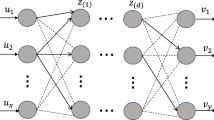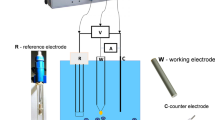Abstract
Considering the simulation of cyclic voltammetry response in the case of porous electrodes that exhibit fractal properties, we propose a numerical technique to solve parameters’ identification problem for the corresponding fractional differential model and study the properties of its implementations in multi-threaded and GPU environments. The one-dimensional model consists of a space-fractional differential equation that describes diffusion and electrochemical reaction processes in a porous electrode and an integer-order diffusion equation for modeling solute transport towards an electrode. Using the L1-approximation of the Caputo derivative, we solve the problem by a finite-difference scheme on a non-uniform grid. Several variants of the particle swarm optimization (PSO) algorithm are applied to reconstruct the values of structural parameters of an electrode—its thickness, roughness, and fractional derivative’s order. Taking into account significantly different solution time for direct problems when the values of parameters vary, we consider an asynchronous and memetic variants of PSO. Testing was performed reconstructing parameters’ values based on the noised solution of the direct problem. Testing results show that memetic PSO algorithm is characterized by the most stable convergence while asynchronous versions of PSO allow the most even loading of CPU cores. Involvement of GPU in the computation process yields its acceleration only on grids with more than 1600 nodes allowing up to \(10\%\) performance gain. Successful testing of the developed technique shows its ability to be used for the analysis of real-world observations and for the prediction of the corresponding processes’ dynamics.








Similar content being viewed by others
Data availability
The codes and data that support the research are available at reasonable request.
References
Atanackovic T, Stankovic B (2008) On a numerical scheme for solving differential equations of fractional order. Mech. Res. Comm. 35(7):429–438
Avila J, Heredi A, Crivello M, Garay F (2019) Theory of square-wave voltammetry for the analysis of an EC reaction mechanism complicated by the adsorption of the reagent. J. Electroanal. Chem. 840:117–124
Baluchová S, Brycht M, Taylor A, Mortet V (2021) Enhancing electroanalytical performance of porous boron-doped diamond electrodes by increasing thickness for dopamine detection. Anal. Chim. Acta 1182:338949
Bohaienko V, Gladky A, Romashchenko M, Matiash T (2021) Identification of fractional water transport model with psi-caputo derivatives using particle swarm optimization algorithm. Appl. Math. Comput. 390:125665
Chevallier F, Jiang L, Jones T, Compton R (2006) Mathematical modelling and numerical simulation of cyclic voltammetry at an electrode covered with an insulating film containing cylindrical micropores. J. Electroanal. Chem. 587:254–262
Chooto P (1997) Cyclic voltammetry and its application. IntechOpen, London, United Kingdom, pp 1–14
Dogan-Topal B, Ozkan S, Uslu B (2010) The analytical applications of square wave voltammetry on pharmaceutical analysis. Open Chem. J. 3:56–73
Du W, Tong L, Tang Y (2018) Metaheuristic optimization-based identification of fractional-order systems under stable distribution noises. Phys. Lett. A 382(34):2313–2320
Effori E, Laurencin J, Tezyk V, Montella C, Dessemond L, Siebert E (2021) A physically-based modelling to predict the cyclic voltammetry response of lscf-type electrodes: Impact of the ohmic losses and microstructure. Solid State Ionics 371:115765
Ford N, Simpson A (2001) The numerical solution of fractional differential equations: Speed versus accuracy. Numer. Algorithms 26(4):333–346
Gorenflo R, Mainardi F (1997) Fractional calculus: integral and differential equations of fractional order. Springer Verlag, Wien, pp 223–276
Harfield JC, Toghill KE, Batchelor-McAuley C, Downing C, Compton RG (2011) Nickel nanoparticle modified BDD electrode shows an electrocatalytic response to adenine and dna in aqueous alkaline media. Electroanalysis 23(4):931–938
Hassan N (2021) Catalytic performance of nanostructured materials recently used for developing fuel cells’ electrodes. Int. J. Hydrog. Energy 46(79):39315–39368
Huang J (2018) Generalization of porous electrode theory for noninteger dimensional space. J. Phys. Chem. C 122:557–565
Kant T, Shrivas K, Dewangan K, Kumar A, Jaiswal N, Deb M, Pervez S (2022) Design and development of conductive nanomaterials for electrochemical sensors: a modern approach. Mater. Today Chem. 24:100769
Kim T, Shin HC, Choi JY, Park MS, Yun WS (2020) Applications of voltammetry in lithium ion battery research. J. Electrochem. Sci. Technol. 11(1):14–25
Le T, Lasseux D, Nguyen X, Vignoles G, Mano N, Kuhn A (2017) Multi-scale modeling of diffusion and electrochemical reactions in porous micro-electrodes. Chem. Eng. Sci. 173:153–167
Lu Q, Rosen J, Zhou Y, Hutchings GS, Kimmel YC, Chen JG, Jiao F (2014) A selective and efficient electrocatalyst for carbon dioxide reduction. Nat. Commun. 5:3242
Lytvynenko AS, Brzózka A, Mishura AM, Kolotilov SV, Sulka GD (2022) Control of Ag nanofoam structure and its electrocatalytic performance in bromobenzene reductive debromination via variation of electrodeposition conditions. Appl. Surf. Sci. 579:152131
Mirceski V, Lovric M (1997) Split square-wave voltammograms of surface redox reactions. Electroanalysis 9(16):1283–1287
Mirceski V, Tomovski Z (2009) Voltammetry based on fractional diffusion. J. Phys. Chem. B 113:2794–2799
Mishura A, Lytvynenko A, Gavrilenko K, Baranchikov A, Grabovaya N, Kiskin M, Kolotilov S (2018) Formation of hierarchically-ordered nanoporous silver foam and its electrocatalytic properties in reductive dehalogenation of organic compounds. New J. Chem. 42:17499
Nicholson R (1965) Theory and application of cyclic voltammetry for measurement of electrode reaction kinetics. Anal. Chem. 37(11):1351–1355
Nicholson R, Shain I (1964) Theory of stationary electrode polarography single scan and cyclic methods applied to reversible, irreversible, and kinetic systems. Anal. Chem. 34(4):706–723
Paradisi P, Cesari R, Mainardi F, Tampieri F (2001) The fractional Fick’s law for non-local transport processes. Phys. A 293:130–142
Podlubny I (1999) Fractional differential equations. Academic Press, New York
Riaz MA, Chen Y (2022) Electrodes and electrocatalysts for electrochemical hydrogen peroxide sensors: a review of design strategies. Nanoscale Horiz 7:463–479
Samarskii A, Vabishchevich P (1995) Computational Heat Transfer. Wiley, New York
Samko S, Kilbas A, Marichev O (1993) Fractional Integrals and Derivatives. Gordon and Breach Science Publishers, New York
Sen S, Liu D, Palmore GTR (2014) Electrochemical reduction of CO\(_2\) at copper nanofoams. ACS Catal. 4(9):3091–3095
Shin HC, Dong J, Liu M (2003) Nanoporous structures prepared by an electrochemical deposition process. Adv. Mater. 15(19):1610–1614
Wagoner ER, Baumberger CP, Gerroll BH, Peters DG (2014) Catalytic reduction of 1,2,5,6,9,10-hexabromocyclododecane by nickel(I) salen electrogenerated at vitreous carbon cathodes in dimethylformamide. Electrochim. Acta 132:545–550
Wang H, Moon I, Yang S, Wang D (2012) A memetic particle swarm optimization algorithm for multimodal optimization problems. Inform. Sci. 197:38–52
Wei T, Li X, Li Y (2015) A tutorial on inverse problems for anomalous diffusion processes. Inverse Probl. 31:035003
Wei T, Li X, Li Y (2016) An inverse time-dependent source problem for a time-fractional diffusion equation. Inverse Probl. 32:085003
Wheatcraft S, Meerschaert M (2008) Fractional conservation of mass. Adv. Water Resour. 31:1377–1381
Zhang Y, Cohen J, Owens JD (2010) Fast tridiagonal solvers on the GPU. In: Proceedings of the 15th ACM SIGPLAN Symposium on Principles and Practice of Parallel Programming, Association for Computing Machinery, New York, NY, USA, PPoPP ’10, pp 127–136
Zhang Y, Wang S, Ji G (2015) A comprehensive survey on Particle Swarm Optimization algorithm and its applications. Math. Probl. Eng. 2015:931256
Author information
Authors and Affiliations
Corresponding author
Ethics declarations
Conflict of interest
On behalf of all the authors, the corresponding author states that there is no conflict of interest.
Additional information
Communicated by Vinicius Albani.
Publisher's Note
Springer Nature remains neutral with regard to jurisdictional claims in published maps and institutional affiliations.
Rights and permissions
Springer Nature or its licensor (e.g. a society or other partner) holds exclusive rights to this article under a publishing agreement with the author(s) or other rightsholder(s); author self-archiving of the accepted manuscript version of this article is solely governed by the terms of such publishing agreement and applicable law.
About this article
Cite this article
Bohaienko, V., Lytvynenko, A. Computational aspects of cyclic voltammetry simulation for the case of porous electrodes of fractal structure. Comp. Appl. Math. 42, 100 (2023). https://doi.org/10.1007/s40314-023-02246-5
Received:
Revised:
Accepted:
Published:
DOI: https://doi.org/10.1007/s40314-023-02246-5
Keywords
- Cyclic voltammetry
- Porous electrodes
- Fractional diffusion equations
- Inverse problems
- Particle swarm optimization
- Parallel computation




